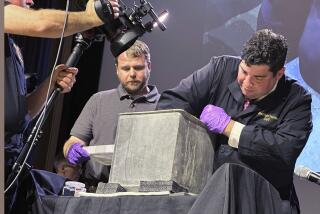Opinion: Paul Revere’s time capsule had a newspaper in it; would a time capsule today have a paper?
- Share via
It’s telling that Paul Revere and Samuel Adams’ 1795 time capsule, stumbled upon last month and opened Tuesday night in Boston, contained five newspapers. If we buried a time capsule in Los Angeles today, sure, we would probably put a copy of the Los Angeles Times in it. But if and when this newspaper is no longer available in print, what would we put in the capsule? A thumb drive? The password to an iCloud account? Some other totem of our tech lives? An iPad — and hope it charges up in 100-plus years so the people who discovered the time capsule could see what we put on it?
Before you dismiss this as just another downer blog post screed on the painful dying of newspapers that you don’t read anymore (although if you’re reading this, at least you venture onto our website), consider how odd it is that we are relegating to the ether all the touchstones of our lives and history.
Not just newspapers. We don’t have record albums or CDs or books; we have iTunes and Spotify and Kindle. We don’t have scrapbooks and photo albums, and we barely have photographs in frames. All the photos are in our iPhones and on our Facebook pages and Instagram feeds. We think we can take them everywhere, yet we don’t really have them. They exist in the cloud (if we save them there), which, I suspect, when global warming has set ablaze all the forests of the world one day, will evaporate and leave us all sobbing in the streets. Without our i-accounts, we have nothing.
OK, so I lied about this not being a downer blog post.
Back to Paul and Sam’s time capsule. There were more relics than the newspapers: coins, a medal depicting George Washington, a silver plaque commemorating the erecting of the Massachusetts State House — which is where they buried the contents of the time capsule when construction on the building was just beginning.
The cornerstone of the state house was ceremoniously pulled by 15 white horses (one for each state of the union) to the building site on July 4, 1795. Revere, Adams — then the governor of Massachusetts — and William Scollay, a colonel in the Revolutionary War, entombed the contents in that cornerstone to the sound of a 15-gun salute. They were first discovered back in 1855, cleaned up a bit, and placed in a brass box and reburied.
There was plenty of fanfare Tuesday night when the contents were opened at the Museum of Fine Arts, with Thomas Sully’s painting of Washington crossing the Delaware on horseback in 1776 providing the backdrop, according to the Boston Globe account. This time there were cameras and lights and the current Massachusetts governor, Deval Patrick.
Certainly we could find something on the order of coins and a plaque or two to throw into our L.A. capsule. Maybe an Oscar statuette. There’s something real and solid that (a few) people get.
But there is an elegance to a physical newspaper — the design, the lettering, the photographs, not to mention, of course, the actual stories. Each day it comes out, it is a historic pamphlet, a memento, a capturing of a moment in the world. It would be good to be able to put at least one newspaper into a time capsule at any time.
Follow the Opinion section on Twitter @latimesopinion
More to Read
A cure for the common opinion
Get thought-provoking perspectives with our weekly newsletter.
You may occasionally receive promotional content from the Los Angeles Times.











